FORD CONTOUR 1999 2.G Owners Manual
Manufacturer: FORD, Model Year: 1999, Model line: CONTOUR, Model: FORD CONTOUR 1999 2.GPages: 244, PDF Size: 2.26 MB
Page 171 of 244
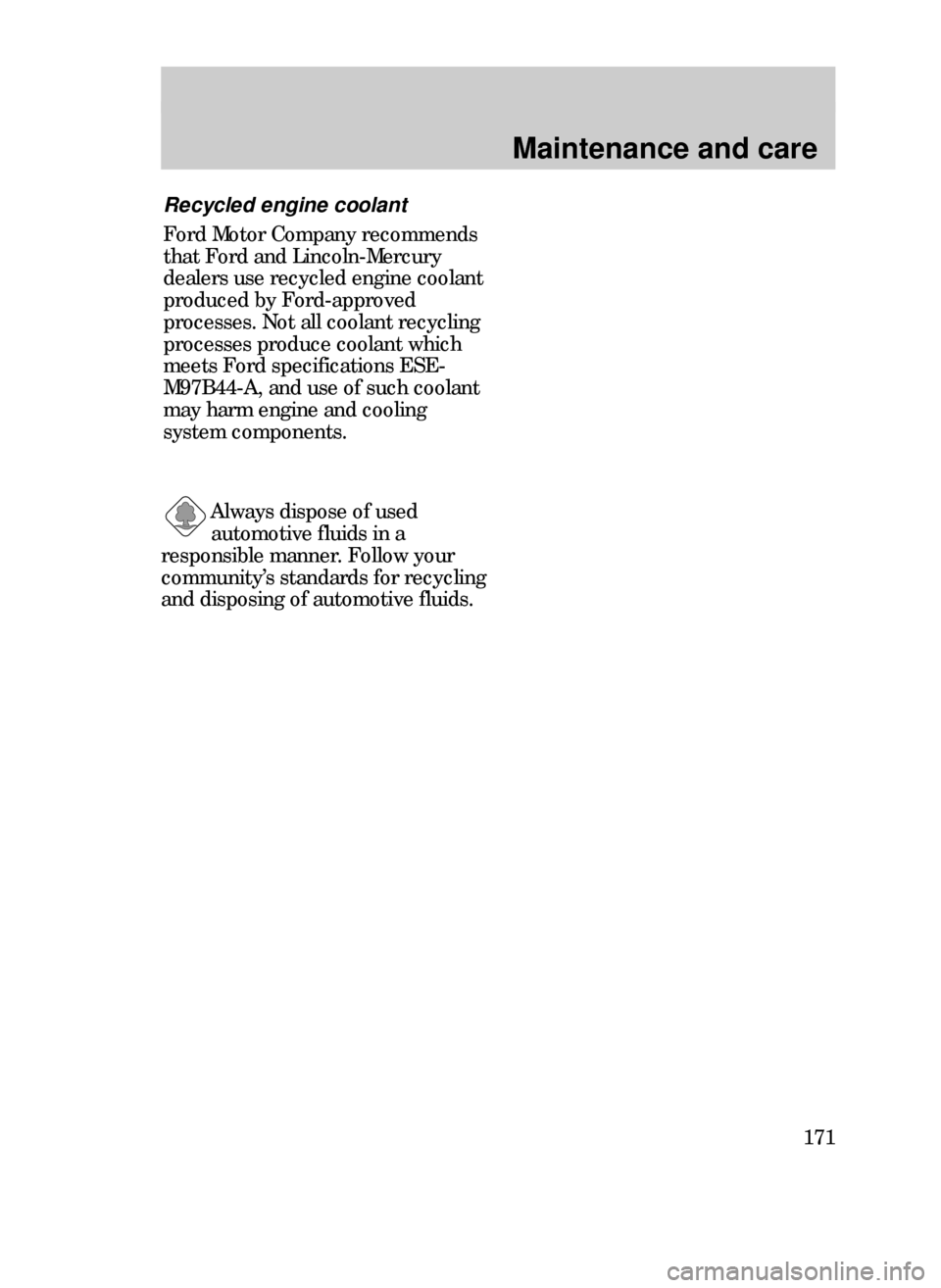
Maintenance and care
171
Always dispose of used
automotive fluids in a
responsible manner. Follow your
communityÕs standards for recycling
and disposing of automotive fluids.
Recycled engine coolant
Ford Motor Company recommends
that Ford and Lincoln-Mercury
dealers use recycled engine coolant
produced by Ford-approved
processes. Not all coolant recycling
processes produce coolant which
meets Ford specifications ESE-
M97B44-A, and use of such coolant
may harm engine and cooling
system components.
31CMCen 3/25/99 3:45 PM Page 171
Page 172 of 244
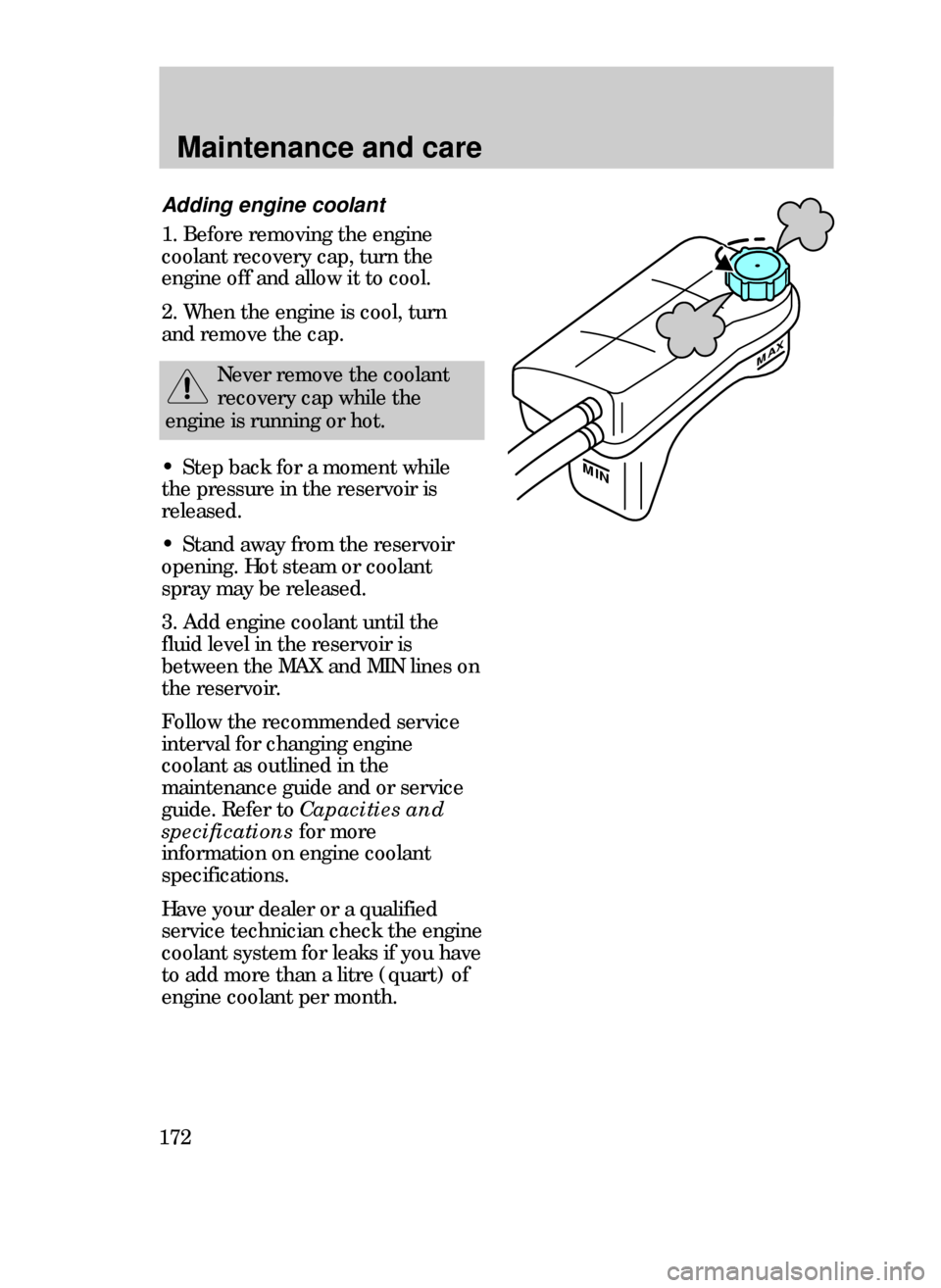
Maintenance and care
172
MAX
MIN
Adding engine coolant
1. Before removing the engine
coolant recovery cap, turn the
engine off and allow it to cool.
2. When the engine is cool, turn
and remove the cap.
Never remove the coolant
recovery cap while the
engine is running or hot.
¥ Step back for a moment while
the pressure in the reservoir is
released.
¥ Stand away from the reservoir
opening. Hot steam or coolant
spray may be released.
3. Add engine coolant until the
fluid level in the reservoir is
between the MAX and MIN lines on
the reservoir.
Follow the recommended service
interval for changing engine
coolant as outlined in the
maintenance guide and or service
guide. Refer to Capacities and
specifications for more
information on engine coolant
specifications.
Have your dealer or a qualified
service technician check the engine
coolant system for leaks if you have
to add more than a litre (quart) of
engine coolant per month.
31CMCen 3/25/99 3:45 PM Page 172
Page 173 of 244
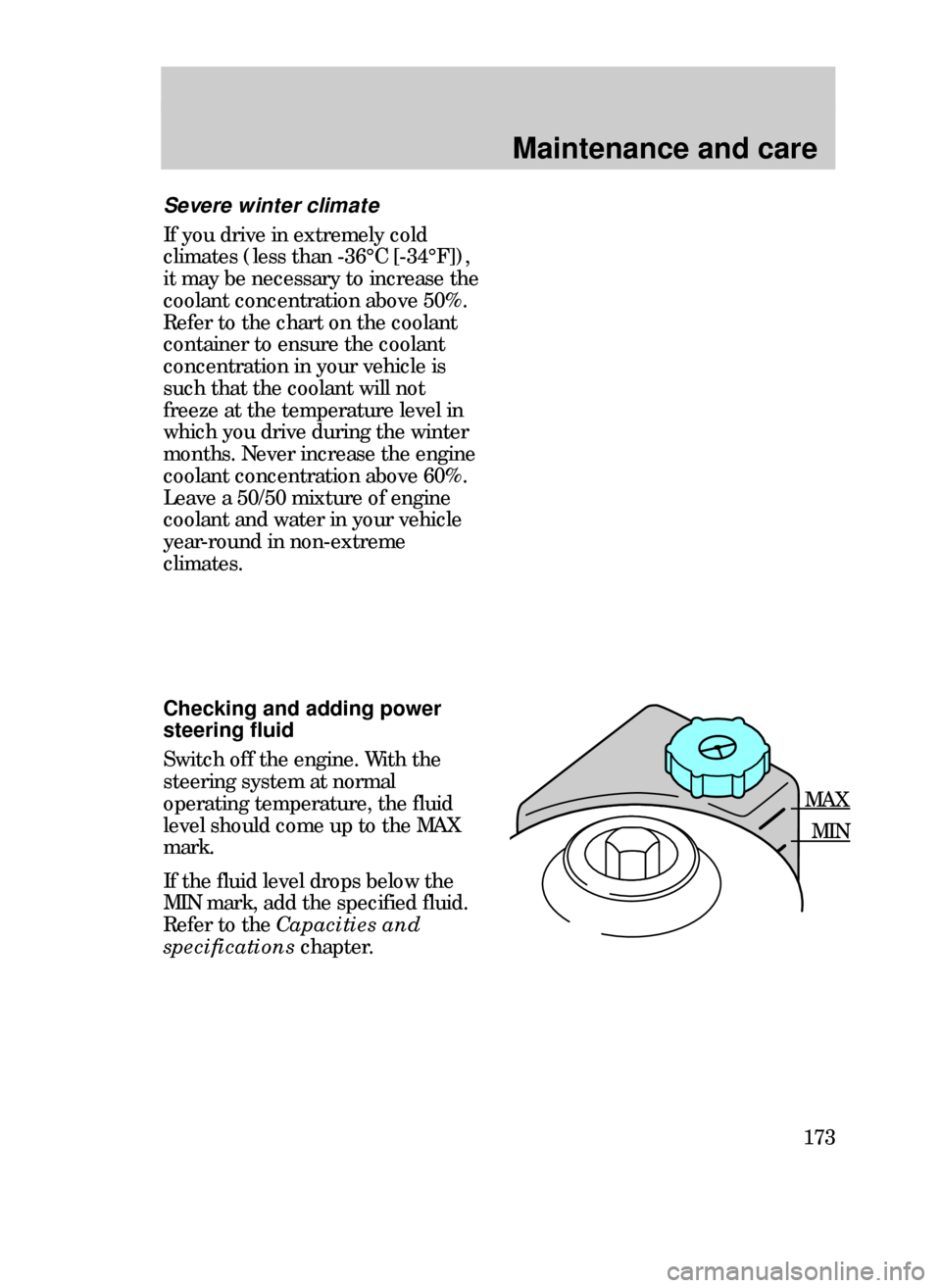
Maintenance and care
173
Checking and adding power
steering fluid
Switch off the engine. With the
steering system at normal
operating temperature, the fluid
level should come up to the MAX
mark.
If the fluid level drops below the
MIN mark, add the specified fluid.
Refer to the Capacities and
specificationschapter.
Severe winter climate
If you drive in extremely cold
climates (less than -36¡C [-34¡F]),
it may be necessary to increase the
coolant concentration above 50%.
Refer to the chart on the coolant
container to ensure the coolant
concentration in your vehicle is
such that the coolant will not
freeze at the temperature level in
which you drive during the winter
months. Never increase the engine
coolant concentration above 60%.
Leave a 50/50 mixture of engine
coolant and water in your vehicle
year-round in non-extreme
climates.
MAX
MIN
31CMCen 3/25/99 3:45 PM Page 173
Page 174 of 244
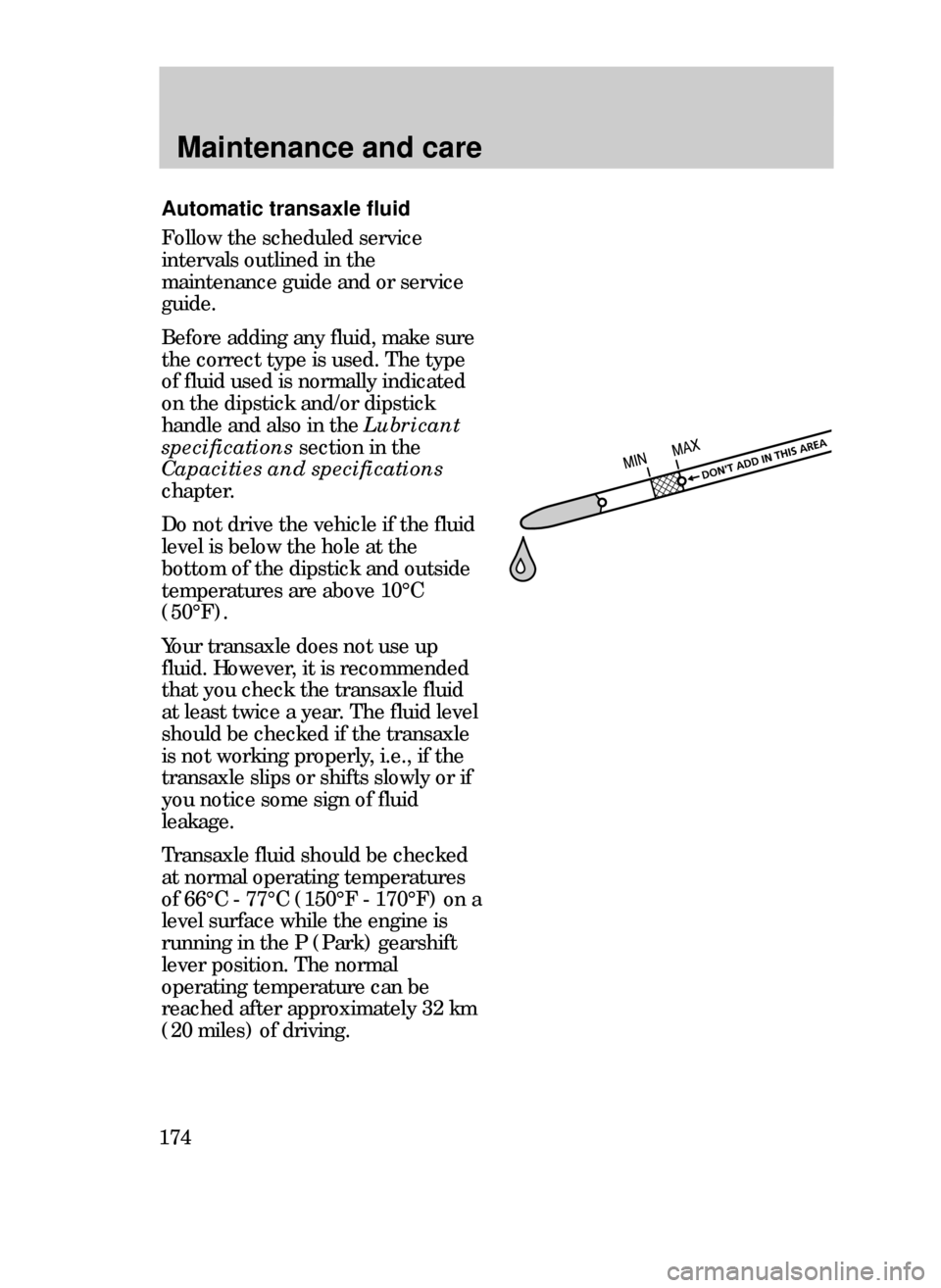
Maintenance and care
174
Automatic transaxle fluid
Follow the scheduled service
intervals outlined in the
maintenance guide and or service
guide.
Before adding any fluid, make sure
the correct type is used. The type
of fluid used is normally indicated
on the dipstick and/or dipstick
handle and also in the Lubricant
specifications section in the
Capacities and specifications
chapter.
Do not drive the vehicle if the fluid
level is below the hole at the
bottom of the dipstick and outside
temperatures are above 10¡C
(50¡F).
Your transaxle does not use up
fluid. However, it is recommended
that you check the transaxle fluid
at least twice a year. The fluid level
should be checked if the transaxle
is not working properly, i.e., if the
transaxle slips or shifts slowly or if
you notice some sign of fluid
leakage.
Transaxle fluid should be checked
at normal operating temperatures
of 66¡C - 77¡C (150¡F - 170¡F) on a
level surface while the engine is
running in the P (Park) gearshift
lever position. The normal
operating temperature can be
reached after approximately 32 km
(20 miles) of driving.
31CMCen 3/25/99 3:45 PM Page 174
Page 175 of 244
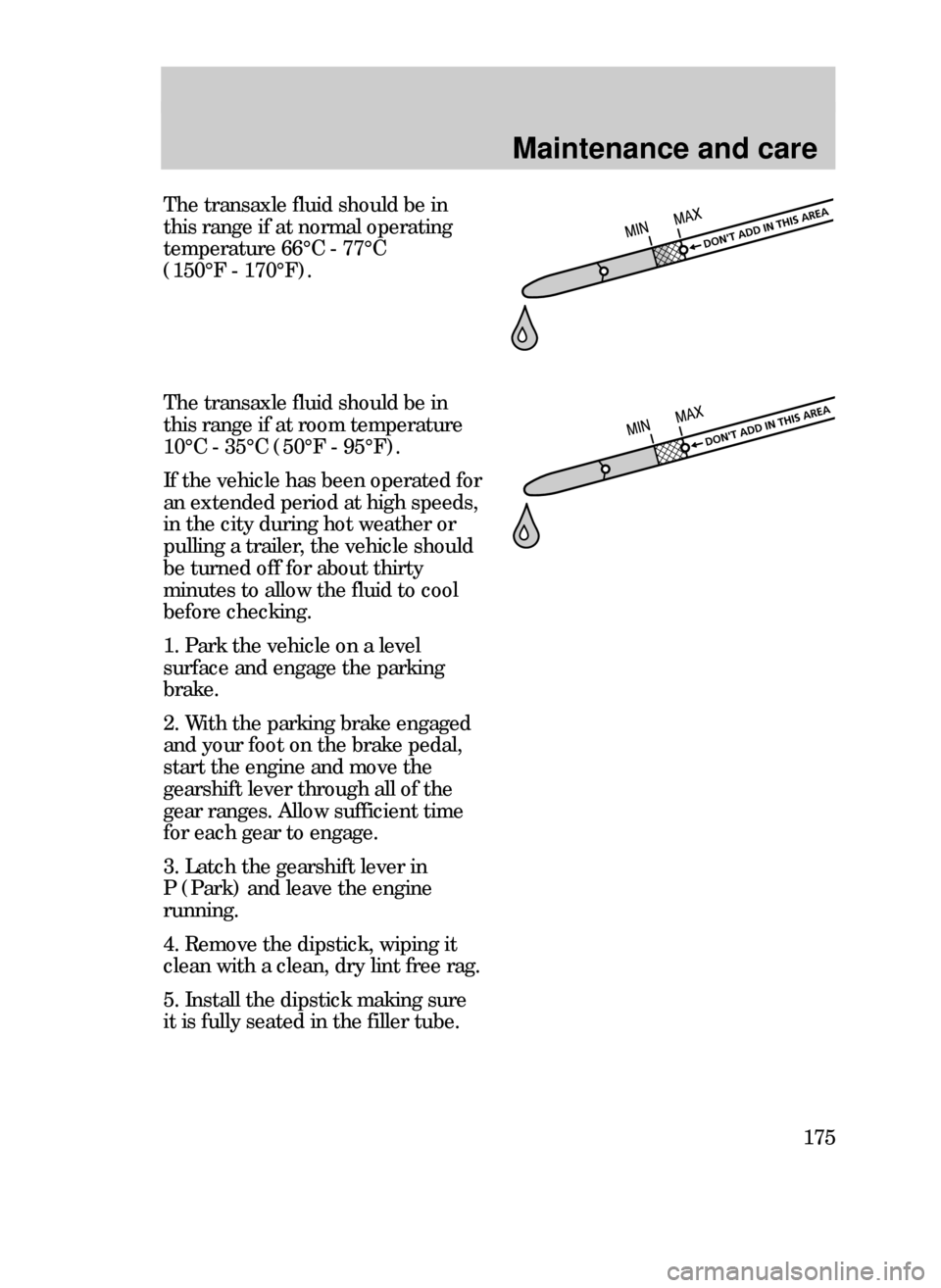
Maintenance and care
175
The transaxle fluid should be in
this range if at normal operating
temperature 66¡C - 77¡C
(150¡F - 170¡F).
The transaxle fluid should be in
this range if at room temperature
10¡C - 35¡C (50¡F - 95¡F).
If the vehicle has been operated for
an extended period at high speeds,
in the city during hot weather or
pulling a trailer, the vehicle should
be turned off for about thirty
minutes to allow the fluid to cool
before checking.
1. Park the vehicle on a level
surface and engage the parking
brake.
2. With the parking brake engaged
and your foot on the brake pedal,
start the engine and move the
gearshift lever through all of the
gear ranges. Allow sufficient time
for each gear to engage.
3. Latch the gearshift lever in
P (Park) and leave the engine
running.
4. Remove the dipstick, wiping it
clean with a clean, dry lint free rag.
5. Install the dipstick making sure
it is fully seated in the filler tube.
31CMCen 3/25/99 3:45 PM Page 175
Page 176 of 244
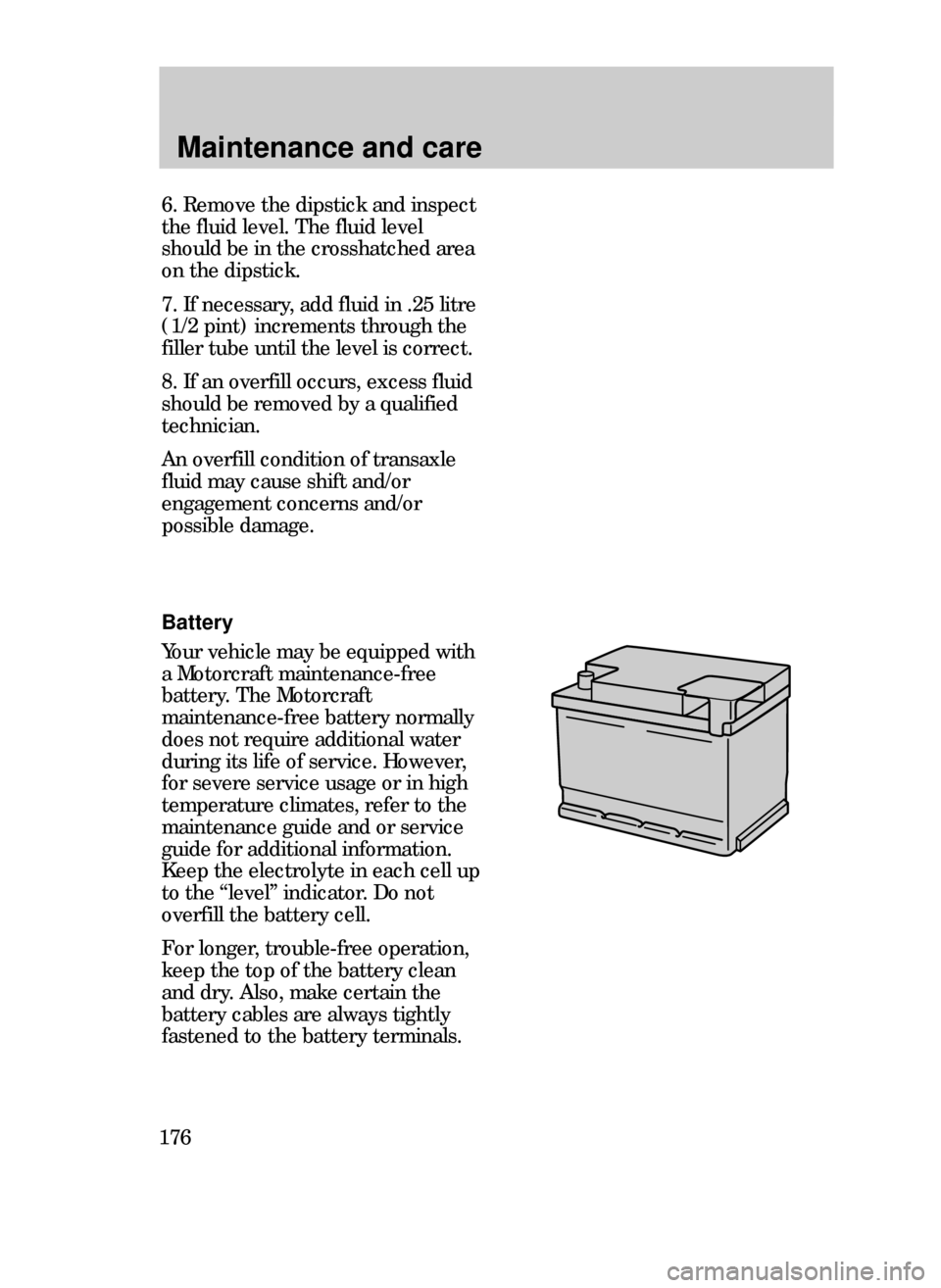
Maintenance and care
176
Battery
Your vehicle may be equipped with
a Motorcraft maintenance-free
battery. The Motorcraft
maintenance-free battery normally
does not require additional water
during its life of service. However,
for severe service usage or in high
temperature climates, refer to the
maintenance guide and or service
guide for additional information.
Keep the electrolyte in each cell up
to the ÒlevelÓ indicator. Do not
overfill the battery cell.
For longer, trouble-free operation,
keep the top of the battery clean
and dry. Also, make certain the
battery cables are always tightly
fastened to the battery terminals.
6. Remove the dipstick and inspect
the fluid level. The fluid level
should be in the crosshatched area
on the dipstick.
7. If necessary, add fluid in .25 litre
(1/2 pint) increments through the
filler tube until the level is correct.
8. If an overfill occurs, excess fluid
should be removed by a qualified
technician.
An overfill condition of transaxle
fluid may cause shift and/or
engagement concerns and/or
possible damage.
31CMCen 3/25/99 3:45 PM Page 176
Page 177 of 244
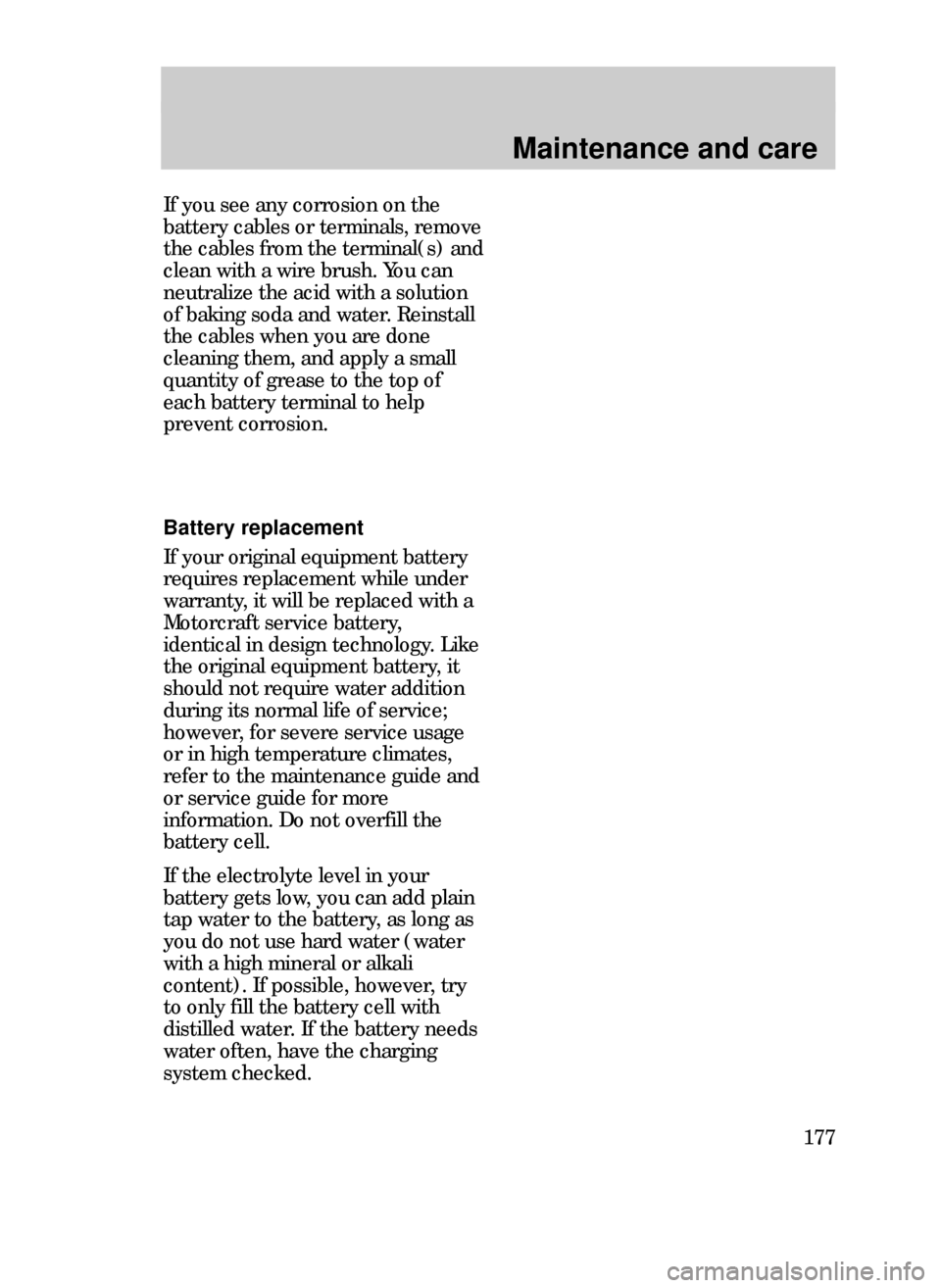
Maintenance and care
177
Battery replacement
If your original equipment battery
requires replacement while under
warranty, it will be replaced with a
Motorcraft service battery,
identical in design technology. Like
the original equipment battery, it
should not require water addition
during its normal life of service;
however, for severe service usage
or in high temperature climates,
refer to the maintenance guide and
or service guide for more
information. Do not overfill the
battery cell.
If the electrolyte level in your
battery gets low, you can add plain
tap water to the battery, as long as
you do not use hard water (water
with a high mineral or alkali
content). If possible, however, try
to only fill the battery cell with
distilled water. If the battery needs
water often, have the charging
system checked.
If you see any corrosion on the
battery cables or terminals, remove
the cables from the terminal(s) and
clean with a wire brush. You can
neutralize the acid with a solution
of baking soda and water. Reinstall
the cables when you are done
cleaning them, and apply a small
quantity of grease to the top of
each battery terminal to help
prevent corrosion.
31CMCen 3/25/99 3:45 PM Page 177
Page 178 of 244
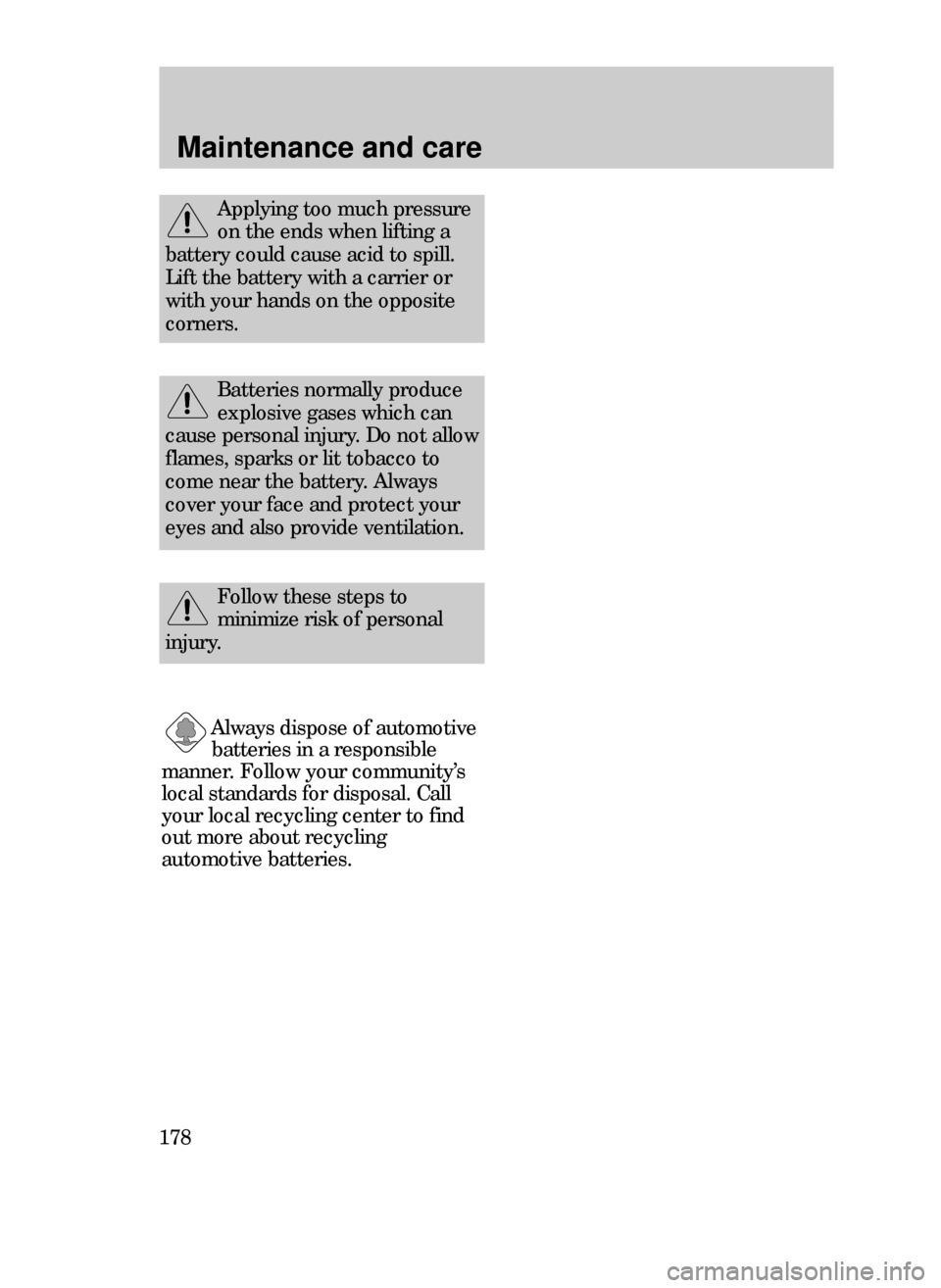
Maintenance and care
178
Batteries normally produce
explosive gases which can
cause personal injury. Do not allow
flames, sparks or lit tobacco to
come near the battery. Always
cover your face and protect your
eyes and also provide ventilation.
Applying too much pressure
on the ends when lifting a
battery could cause acid to spill.
Lift the battery with a carrier or
with your hands on the opposite
corners.
Follow these steps to
minimize risk of personal
injury.
Always dispose of automotive
batteries in a responsible
manner. Follow your communityÕs
local standards for disposal. Call
your local recycling center to find
out more about recycling
automotive batteries.
31CMCen 3/25/99 3:45 PM Page 178
Page 179 of 244
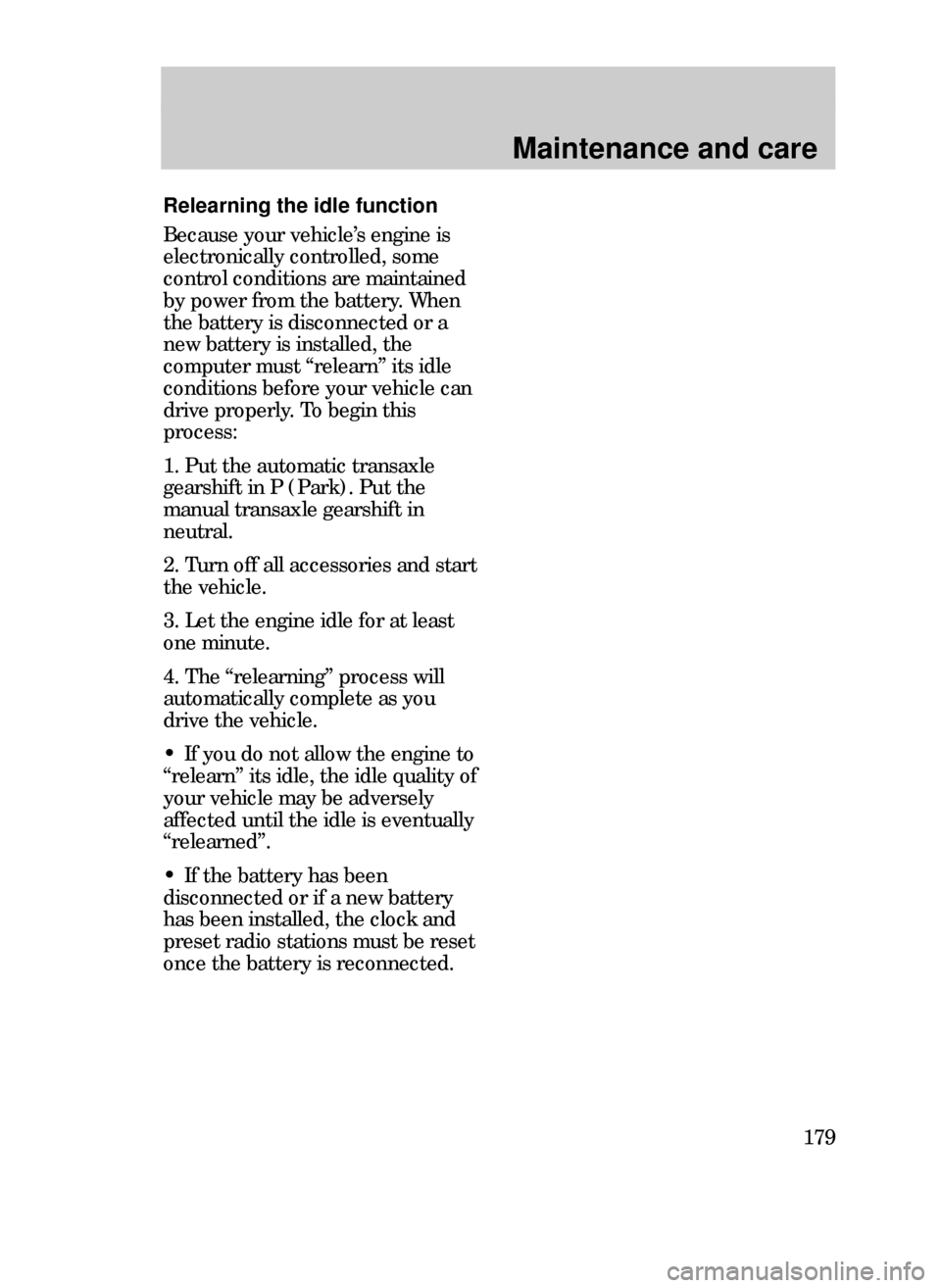
Maintenance and care
179
Relearning the idle function
Because your vehicleÕs engine is
electronically controlled, some
control conditions are maintained
by power from the battery. When
the battery is disconnected or a
new battery is installed, the
computer must ÒrelearnÓ its idle
conditions before your vehicle can
drive properly. To begin this
process:
1. Put the automatic transaxle
gearshift in P (Park). Put the
manual transaxle gearshift in
neutral.
2. Turn off all accessories and start
the vehicle.
3. Let the engine idle for at least
one minute.
4. The ÒrelearningÓ process will
automatically complete as you
drive the vehicle.
¥ If you do not allow the engine to
ÒrelearnÓ its idle, the idle quality of
your vehicle may be adversely
affected until the idle is eventually
ÒrelearnedÓ.
¥ If the battery has been
disconnected or if a new battery
has been installed, the clock and
preset radio stations must be reset
once the battery is reconnected.
31CMCen 3/25/99 3:45 PM Page 179
Page 180 of 244
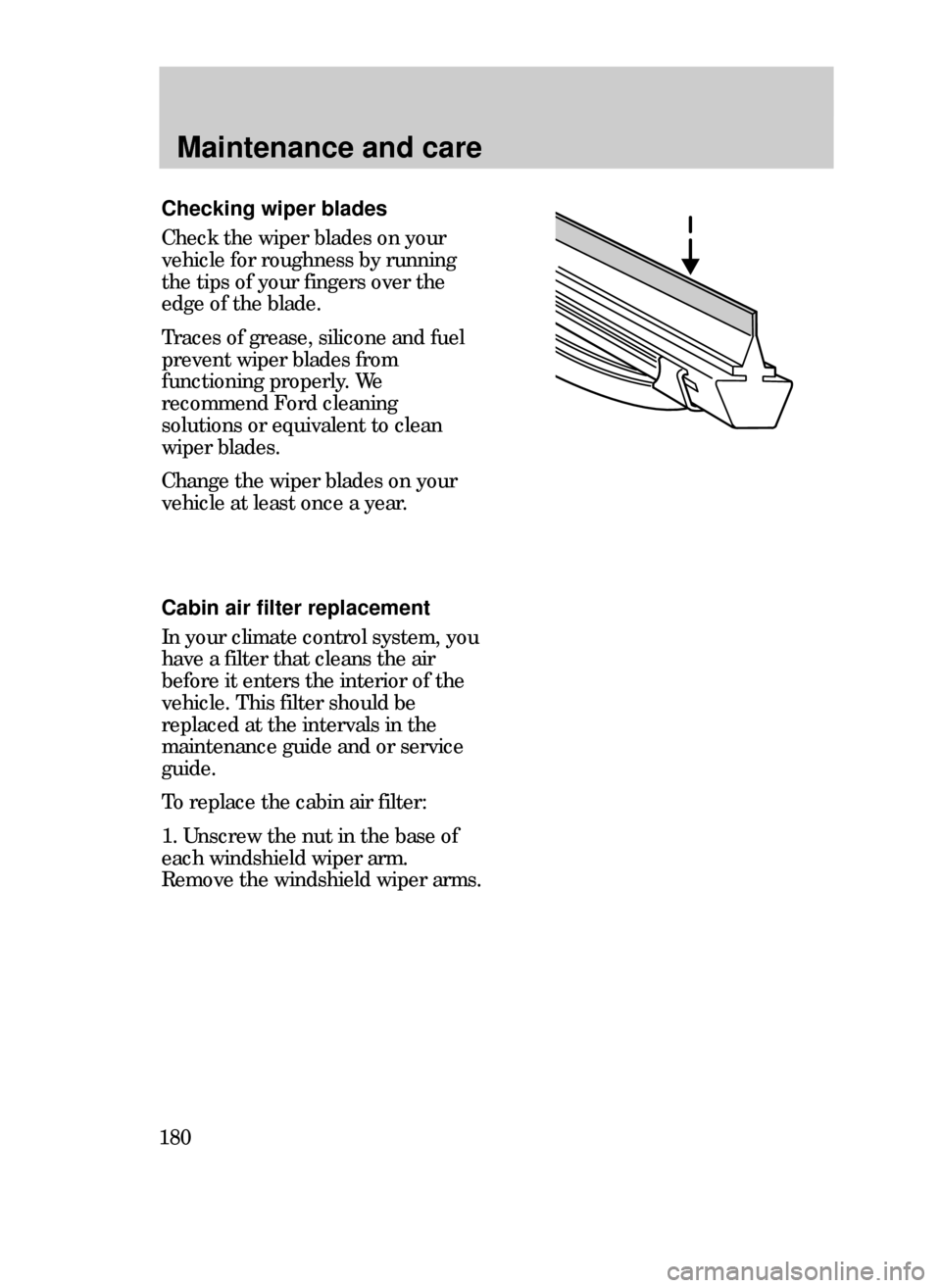
Maintenance and care
180
Checking wiper blades
Check the wiper blades on your
vehicle for roughness by running
the tips of your fingers over the
edge of the blade.
Traces of grease, silicone and fuel
prevent wiper blades from
functioning properly. We
recommend Ford cleaning
solutions or equivalent to clean
wiper blades.
Change the wiper blades on your
vehicle at least once a year.
Cabin air filter replacement
In your climate control system, you
have a filter that cleans the air
before it enters the interior of the
vehicle. This filter should be
replaced at the intervals in the
maintenance guide and or service
guide.
To replace the cabin air filter:
1. Unscrew the nut in the base of
each windshield wiper arm.
Remove the windshield wiper arms.
31CMCen 3/25/99 3:45 PM Page 180